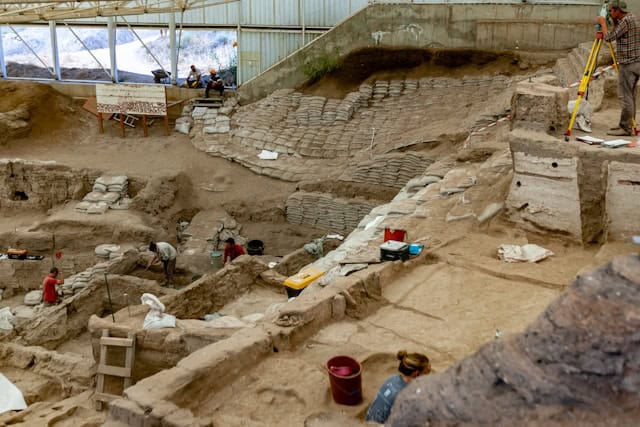Introduction
Archaeology, traditionally reliant on manual excavation and analysis, has been revolutionized by modern technology. Today, advanced tools and methodologies enable archaeologists to uncover the past more efficiently and accurately than ever before. This article explores several key innovations in archaeological technology and their impact on the field.
Remote Sensing Technologies
LiDAR (Light Detection and Ranging)
LiDAR technology uses laser pulses to create detailed 3D maps of the ground surface, even through dense vegetation. This technology has been instrumental in discovering hidden archaeological sites in areas like the dense jungles of Central America.
“LiDAR has completely transformed our approach to archaeology, allowing us to see beneath the canopy and reveal structures that were previously invisible,” says Dr. Elizabeth Graham, an expert in Mesoamerican archaeology.
Satellite Imagery
High-resolution satellite imagery enables archaeologists to identify potential excavation sites from space. These images can reveal subtle changes in vegetation and soil that indicate the presence of ancient structures.
“Satellite imagery provides a macro view that is invaluable for identifying large-scale patterns and connections between sites,” notes Dr. Sarah Parcak, a pioneer in space archaeology.
Ground-Penetrating Radar (GPR)
GPR is a non-invasive method that uses radar pulses to detect and map subsurface structures. This technology is particularly useful for locating graves, buildings, and other buried features without disturbing the soil.
“Ground-penetrating radar allows us to explore what lies beneath the surface with great precision, reducing the need for extensive digging,” explains Dr. John Waddell, a specialist in geophysical archaeology.
3D Modeling and Photogrammetry
3D Scanning
3D scanning technology captures detailed images of artifacts and structures, which can be used to create digital models. These models help researchers analyze objects without handling them, preserving fragile items and providing new insights.
“3D scanning has opened up new possibilities for studying artifacts in detail, enabling us to see and share intricate details that would be impossible with traditional methods,” states Dr. Rebecca Jones, an archaeologist at the University of Edinburgh.
Photogrammetry
Photogrammetry involves taking multiple photographs of an object or site from different angles and using software to create a 3D model. This method is cost-effective and highly accurate, making it accessible for various archaeological projects.
“Photogrammetry allows us to create detailed, accurate models of sites and artifacts, facilitating analysis and virtual reconstruction,” says Dr. Chris Fisher, a leading figure in digital archaeology.
DNA Analysis
Advances in DNA analysis have revolutionized bioarchaeology, providing new insights into ancient populations, their diets, diseases, and migrations. By extracting and analyzing DNA from bones and teeth, researchers can reconstruct genetic histories and understand the biological relationships between ancient peoples.
“DNA analysis has given us a window into the lives of ancient populations, revealing connections and migrations that were previously unknown,” explains Dr. Eske Willerslev, a geneticist specializing in ancient DNA.
Artificial Intelligence and Machine Learning
Artificial Intelligence (AI) and Machine Learning (ML) are increasingly being used to analyze large datasets in archaeology. These technologies can identify patterns and anomalies that may indicate the presence of archaeological sites or artifacts.
“AI and machine learning are powerful tools for processing and interpreting the vast amounts of data we collect, helping us make sense of complex patterns and trends,” notes a local expert from .
Drones and Aerial Surveying
Drones equipped with cameras and sensors have become invaluable in archaeology, providing aerial views of sites and helping to identify features that are not visible from the ground. They are also used to create detailed maps and monitor excavation progress.
“Drones offer a unique perspective, allowing us to survey large areas quickly and efficiently, which is particularly useful in remote or difficult-to-access locations,” says Dr. David Kennedy, an archaeologist known for his work with aerial surveying.
The Role of Technology in Public Engagement
Technology is also enhancing public engagement with archaeology. Virtual reality (VR) and augmented reality (AR) applications allow people to explore archaeological sites and artifacts in immersive, interactive ways. Museums and educational institutions are using these technologies to bring history to life and make it accessible to a broader audience.
“Virtual and augmented reality experiences are transforming how we share archaeological discoveries, making them more engaging and accessible to the public,” states Dr. Rachel Wood, a curator at a leading archaeological museum.
The integration of advanced technologies in archaeology is transforming how researchers uncover, analyze, and interpret the past. From remote sensing and 3D modeling to DNA analysis and AI, these tools are providing new insights and revolutionizing the field. As technology continues to evolve, its role in archaeology will only expand, opening up new possibilities for discovering and understanding our ancient history.
“Embracing technological innovation is crucial for the future of archaeology, allowing us to uncover and preserve our past more effectively than ever before,” concludes Dr. Michael Smith, a renowned archaeologist and advocate for technological integration in the field.


